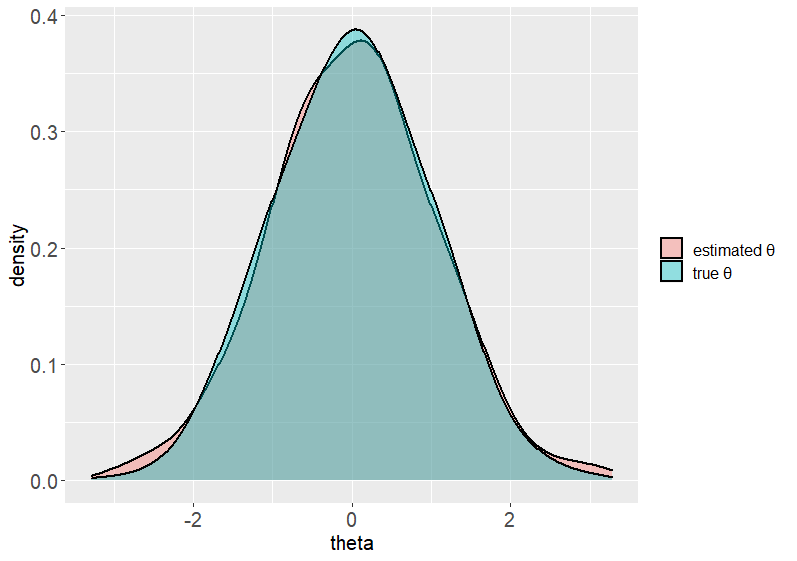Maximum Likelihood Estimation of Examinees' Ability Using Newton's Method
December 01, 2020
Obtaining the examinee's ability estimate is always the very first step for a psychometrician to move further, for example, servicing for the selection of the next item during the process of online calibration or adaptive testing. In this article, a detailed description of R codes for maximum likelihood estimation using Newton-Raphson accompanied by the implementation of the downhill algorithm is presented. With these codes, you can easily use them to estimate your own theta with your item parameters!
The MLE with the downhill algorithm will be illustrated within the framework of two-parameter logistic item response model (2PLM),
so you will learn how to:
- function1: Newtons, Newton-Raphson method of theta estimation for 2PLM (with the implement of downhill algorithm)
- function2: GridSearch, Grid-Search method of theta estimation for 2PLM (an option for the estimation of score of 0 or full scores)
the estimation main body (with boundary manipulation)
- plot estimate theta results
- save results
- return bias, RMSE and timecost to the console
Before we get started, it would be a good idea to clean our environment, record the starting time point, and set our working directory.
rm(list = ls())
time.start <- Sys.time()
# library packages ----------------------------------------
## This package can help you to produce gorgeous graphs
library(ggplot2)
# set working directory -----------------------------------
setwd("C:/Users/HYS/Desktop") ## You need to modify to your WDNext, let's take a close look at the core functions.
# define functions ----------------------------------------
Newtons <- function(theta0, response, a, b, D = 1.702, lamda = 1, ep = 1e-08, maxiter = 500){
## Newton-Raphson method of theta estimation for 2PLM
th <- theta0
re <- response
niter <- 0
delta <- ep + 1
while (delta >= ep && niter <= maxiter) {
niter <- niter + 1
## 2PL model
Pi <- 1 /(1 + exp(-D * a * (th - b)))
Pi[Pi == 0] <- 1e-10
Pi[Pi == 1] <- 1 - 1e-10
Q <- 1 - Pi
fx <- sum(D * a * (re - Pi)) # first derivative, i.e., g(θ)
dfx <- -D^2 * sum(a^2 * Pi * Q) # second derivative, i.e., g'(θ)
## detect if the slope is zero
if (dfx == 0) {
warning("Slope is zero!")
break
}
delta <- lamda * fx/dfx
## implement the downhill algorithm
j <- 0
Pi1 <- 1 /(1 + exp(-D * a * (th - delta - b)))
fx1 <- sum(D * a * (re - Pi1)) # compute g(θk+1)
fx0 <- fx # compute g(θk)
while (abs(fx1) >= abs(fx0)) {
j <- j + 1
lamda <- lamda/(2^j)
delta <- lamda * fx/dfx
Pi1 <- 1 /(1 + exp(-D * a * (th - delta - b)))
fx1 <- sum(D * a * (re - Pi1))
}
th <- th - delta
}
## detect the misconvergence
if (niter > maxiter) {
warning("Maximum number of iterations was reached.")
}
return(list(root = th, niter = niter, estim.prec = delta))
}
GridSearch <- function(response, a, b, D = 1.702, upper = 4, lower = -4, stepsize = 1e-03){
## Grid-Search method of theta estimation for 2PLM
th <- seq(from = lower, to = upper, by = stepsize)
np = length(th)
## compute log-likelihood function
logf <- function(x, r, a, b, D) {
pi = 1/(1 + exp(-D * a * (x - b)))
ll = r * log(pi) + (1 - r) * log(1 - pi)
lf = sum(ll)
return(lf)
}
## for each theta in [lower, upper]
lnL <- sapply(1:np, function(i){
logf(x = th[i], r = response, a = a, b = b, D = D)
})
th <- th[order(lnL, decreasing = TRUE)]
estth <- th[1]
}
Are you ready for estimating our example data? Here we go!
# main body -----------------------------------------------
## read data
response <- read.table("response_matrix.txt")
theta <- read.table("theta_parameter.txt")
itemPara <- read.table("item_parameter.txt")
## set variables
D <- 1.702
lamda <- 1
upper <- 4
lower <- -4
epsilon <- 1e-08
maxiter <- 1000
stepsize <- 1e-05
## estimate theta for all examinees
a <- itemPara[, 1]
b <- itemPara[, 2]
nperson <- dim(response)[1]
nitem <- dim(itemPara)[1]
est.th <- array(data = NA, dim = nperson)
for (i in 1:nperson) {
score <- sum(response[i, ])
## check score of 0 or full scores
if(score == 0) {
est.th[i] <- -3
## if we want to use the Grid-Search method, that is:
## est.th[i] <- GridSearch(response = response[i, ], a = a, b = b, D = D,
## upper = upper, lower = lower, stepsize = stepsize)
}else if (score == nitem){
est.th[i] <- 3
}else{
theta0 = log((score) / (nitem - score))
est.th[i] <- Newtons(theta0 = theta0, response = response[i, ], a = a, b = b, D = D,
lamda = lamda, ep = epsilon, maxiter = maxiter)$root
}
## boundary manipulation
if(est.th[i] > upper) {
est.th[i] <- upper
print(paste("The ", i, "th estimated theta is out of range.", sep = ""))
}else if (est.th[i] < lower) {
est.th[i] <- lower
print(paste("The ", i, "th estimated theta is out of range.", sep = ""))
}
## progress bar
print(paste("Finish: ", sprintf(fmt = '%0.1f', i/nperson * 100), "% for ",
nperson, " examinees.", sep = ""))
}
## compute the indexs
bias <- mean(est.th - theta[, 1])
RMSE <- sd(est.th - theta[, 1])
After the estimation, we surely want to know the accuracy of our estimators. So, let's plot the estimated abilities and true values. Also, do not forget to save our results.
# plot estimate theta results -----------------------------
## generate a density plot
data <- data.frame(
type = rep(x = c("estimated θ", "true θ"), each = nperson),
theta = c(est.th, theta[, 1]))
pic <- ggplot(data = data, aes(x = theta, group = type, fill = type)) +
geom_density(adjust = 1.5, alpha = 0.4, size = 0.75) +
theme(text = element_text(size = 15, family = "sans"),
axis.text.x = element_text(size = 15),
axis.text.y = element_text(size = 15),
legend.title = element_blank())
pic
# save results --------------------------------------------
result <- cbind.data.frame(est.th, theta)
colnames(result) <- c("est_theta", "true_theta")
write.csv(x = result, file = "est_theta.csv", row.names = FALSE)
timeCost <- Sys.time() - time.start
# return the results to the console -----------------------
print(list(bias = bias, RMSE = RMSE, timeCost = timeCost))

The density plot of the results.
You have done a terrific job! Now you can use these codes to estimate your own theta with your a and b parameters! Also, feel free to ask me any questions.
